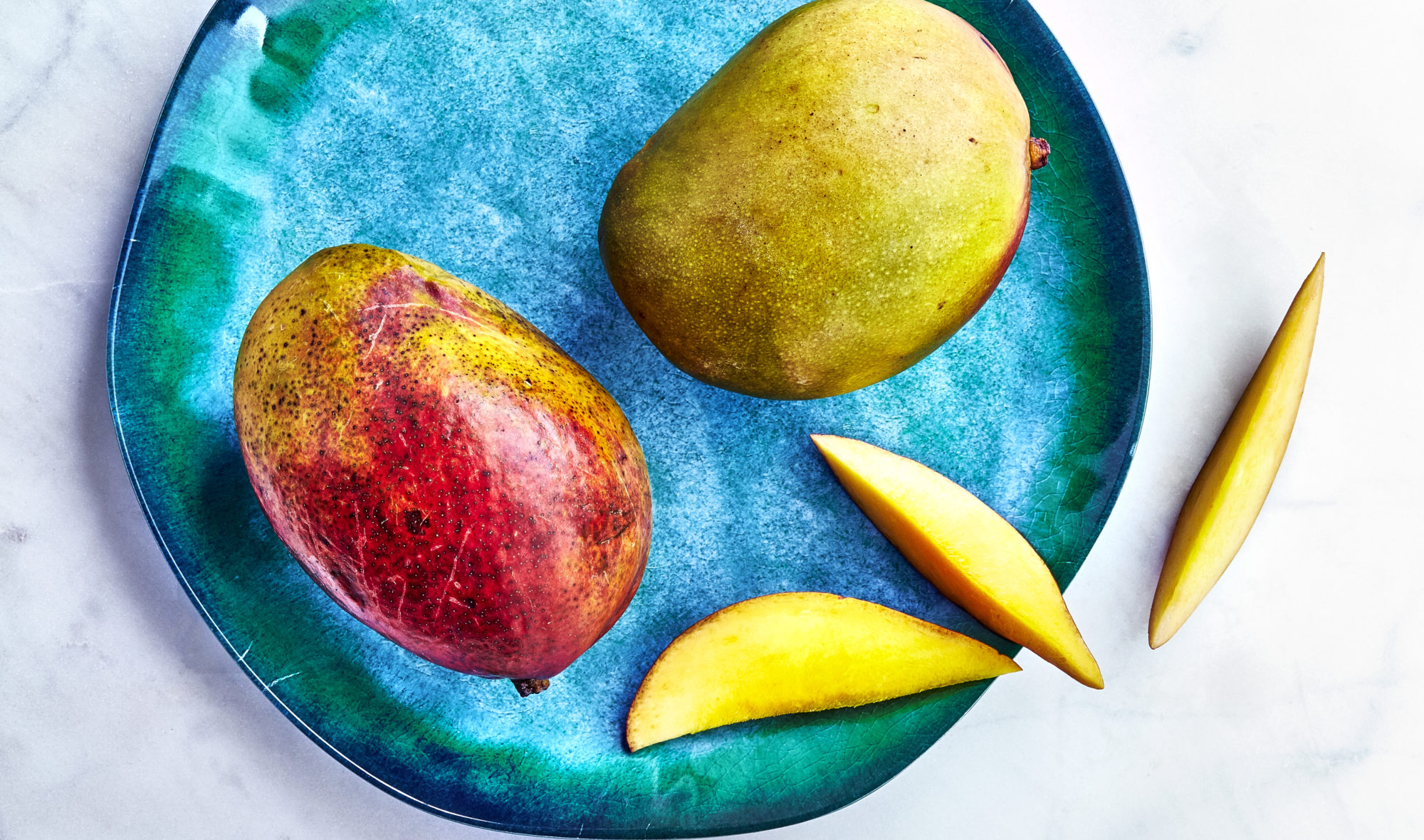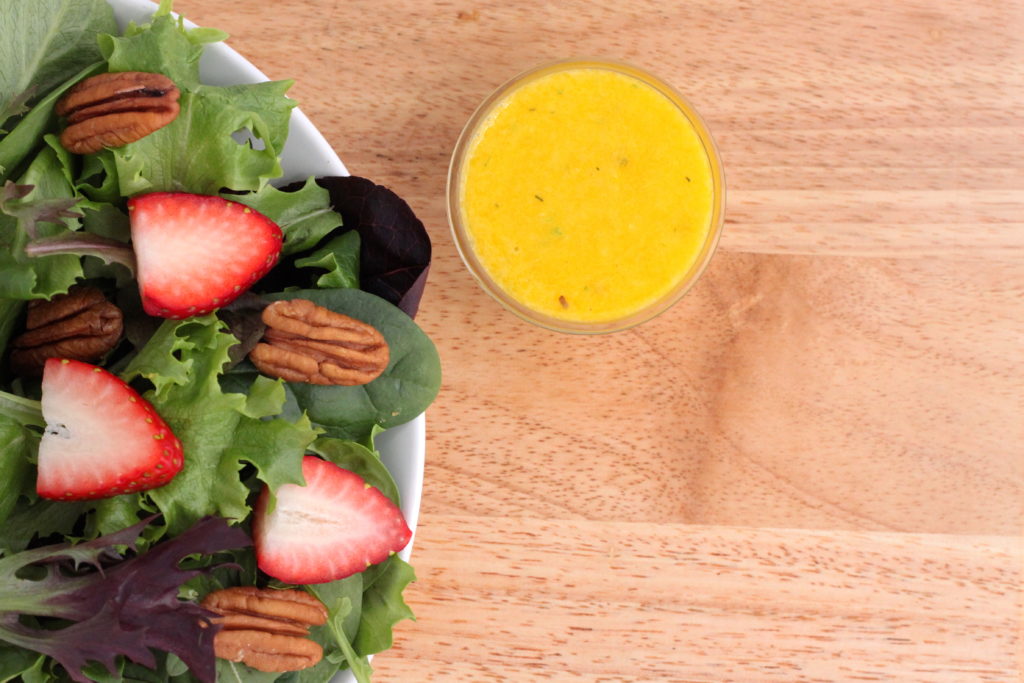Mango


The mango is a sweet, juicy stone fruit. Over 1,000 different varieties of mangoes exist, and they grow in tropical locations all over the world. Mangoes boast many vitamins; in particular, you can get a day’s worth of vitamin C from one cup of mangoes. Look for mangoes that yield to gentle pressure but aren’t overly soft and squishy. If they are hard, let mangoes ripen in a paper bag on the counter. To enjoy, remove the outer peel and cut the flesh away from the hard, white pit in the center of the fruit. Cutting into a mango can be slippery work so exercise caution with your knife. Enjoy mangoes in desserts, savory dishes, or on their own as a sweet snack.
The mango is a stone fruit that grows in tropical locations and is known for its big flavor and sweet juice.
There are over 1,0000 different mango varieties cultivated around the world. Given its widespread geography, it’s no surprise that mangoes are used in many different cuisines including Thai, Indian, Mexican, Filipino, and Caribbean. (It’s even the national fruit of India, Pakistan and the Philippines, and the mango tree is the national tree of Bangladesh.)
In the US, mangoes are commonly imported from Mexico, as well as Ecuador, Peru, Brazil, Guatemala and Haiti. The mango growing year has two seasons: one in the spring/summer and one in the fall/winter. As a result of its geographic locations and growing seasons, mangoes are generally available in the US all year long.
Among the many types of mangoes, there are two types you’re most likely to find.
Mangoes of the Tommy Atkins variety are generally the most common. They are a fairly large, heavy fruit, with a rounded oval shape, and red, yellow and green colored skin.
You may also encounter Altufo or “champagne mangoes”. These are longer and narrower with a bright yellow color.
While flavor and bouquet vary by variety, ripe mangoes have a sweet, aromatic scent. The flesh is yellow-orange colored, fragrant, and juicy.
One half-cup of raw mangoes contains about 50 calories, 0.68g of protein, 0.31g of fat, 12.36g of carbohydrates, 1.3g of fiber, and 11.27g of sugar.
Mangoes are packed with vitamins — most notably, they are a good source of vitamin B6, vitamin A, and vitamin C. (One cup of mangoes fulfills 100% of your daily vitamin C needs.) Mangoes also contain copper, potassium, and magnesium.
For ripeness, look for bright color: Tommy Atkins mangoes should be red and yellow, with limited green patches. Altufos should be bright yellow. Certain mangoes (such as the Keitt variety) are green when ripe, but for most varieties this means they’re not ready to eat yet.
The fruit should have a slight give to it when pressed gently. If it feels very firm it is not ripe and may take a few days yet to ripen. Alternatively, if it is very soft and squishy that means it’s over-ripe.
Some mango varieties – including Altufo mangoes – are sensitive and should be handled with care. Check the mangoes for any major blemishes, bruises or soft spots before buying.
Let mangoes ripen on the counter. Putting them in a paper bag can hasten this process.
Once ripe, you can store mangoes in a plastic bag in the refrigerator for up to five days.
Cut mangoes will last for a few days in the fridge, but the fruit is best enjoyed shortly after being cut for maximum flavor and freshness.
First you must remove the tough, thin skin. You can do this with a sharp paring knife or a sharp vegetable peeler. If the mango is ripe enough, you may be able to make a few small cuts around the top of the mango, then simply peel the skin away with your hands.
When cutting through a mango, exercise caution: they can be quite slippery due to their juiciness.
At the center of the mango is a large, tough white pit. This is particularly true for common mangoes (Altufo mangoes have a smaller pit and more flesh.) Note that the flesh surrounding the pit is tough and fibrous; the riper the fruit, the less tough and fibrous flesh there will be. Cut around these areas.
For breakfast, mangoes can be enjoyed as topping for yogurt, oatmeal or cereal, or add to smoothies.
Mangoes can also be enjoyed in savory preparations. Sweet, aromatic mangoes are a great canvas for building lots of flavor. For example, use mango slices in a salad, stir cubes of mango into guacamole or homemade salsa, roast mango chunks with chicken or pork, or puree to make a tropical glaze for grilled meat.
Mangoes are great in desserts: use them in fruit tarts, add them to coconut rice pudding, or turn them into sorbet. Of course, mangoes are so sweet they make a great dessert on their own: add a sprig of mint to garnish a serving of cut mango and enjoy.

A dressing with fiber? Who knew! The mango gives this dressing a naturally sweet and creamy texture - which is ultimately what we crave in sauces and dressings. It’s sure to wake up your taste buds and be a welcomed change to your usual vinaigrette.
Prep Time: 2 minutes Cook Time: 0 minutes Yield: 1 cup
Combine all ingredients in a food processor or blender and blend until very smooth. Store for 3-4 days in the fridge.
Note: this dressing will get thicker in the fridge – you can let it sit on the counter for a bit or add a bit of water to it as you go if you’re storing it for the week.
Precision Nutrition’s Encyclopedia of Food expands every single month as we highlight new foods and showcase beautiful food photography. If you’d like to stay up to date, simply click this link. From there, we’ll send you a FREE copy of our recipe book. We’ll also let you know when new and delicious foods are added to the site.
The mango is a sweet, juicy stone fruit. Over 1,000 different varieties of mangoes exist, and they grow in tropical locations all over the world. Mangoes boast many vitamins; in particular, you can get a day’s worth of vitamin C from one cup of mangoes. Look for mangoes that yield to gentle pressure but aren’t overly soft and squishy. If they are hard, let mangoes ripen in a paper bag on the counter. To enjoy, remove the outer peel and cut the flesh away from the hard, white pit in the center of the fruit. Cutting into a mango can be slippery work so exercise caution with your knife. Enjoy mangoes in desserts, savory dishes, or on their own as a sweet snack.